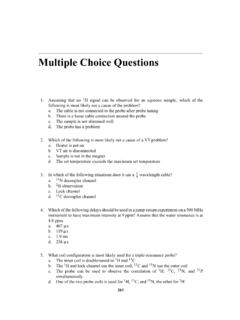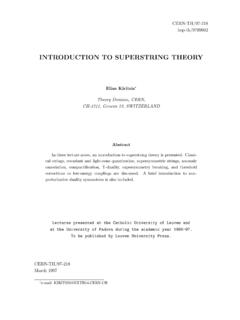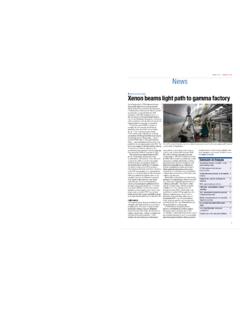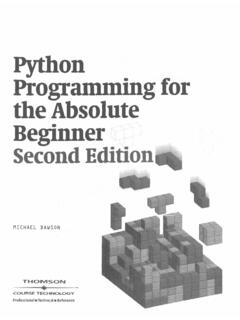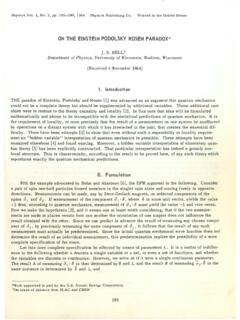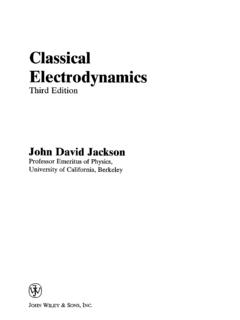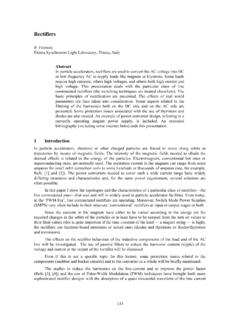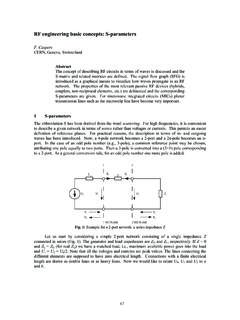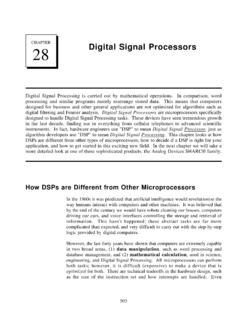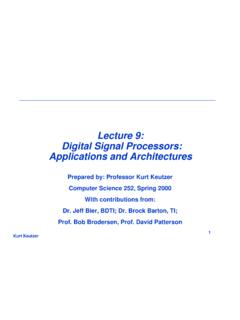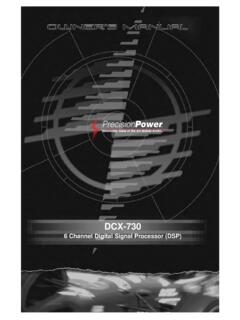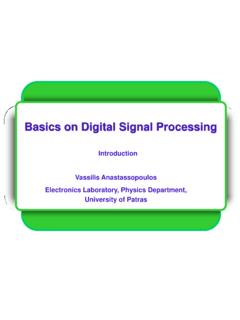Transcription of Digital signal processor fundamentals and system design
1 1 Digital signal processor fundamentals and system design Angoletta CERN, Geneva, Switzerland Abstract Digital signal Processors (DSPs) have been used in accelerator systems for more than fifteen years and have largely contributed to the evolution towards Digital technology of many accelerator systems, such as machine protection, diagnostics and control of beams, power supply and motors. This paper aims at familiarising the reader with DSP fundamentals , namely DSP characteristics and processing development. Several DSP examples are given, in particular on Texas Instruments DSPs, as they are used in the DSP laboratory companion of the lectures this paper is based upon. The typical system design flow is described; common difficulties, problems and choices faced by DSP developers are outlined; and hints are given on the best solution.
2 1 Introduction Overview Digital signal Processors (DSPs) are microprocessors with the following characteristics: a) Real-time Digital signal processing capabilities. DSPs typically have to process data in real time, , the correctness of the operation depends heavily on the time when the data processing is completed. b) High throughput. DSPs can sustain processing of high-speed streaming data, such as audio and multimedia data processing. c) Deterministic operation. The execution time of DSP programs can be foreseen accurately, thus guaranteeing a repeatable, desired performance. d) Re-programmability by software. Different system behaviour might be obtained by re-coding the algorithm executed by the DSP instead of by hardware modifications.
3 DSPs appeared on the market in the early 1980s. Over the last 15 years they have been the key enabling technology for many electronics products in fields such as communication systems, multimedia, automotive, instrumentation and military. Table 1 gives an overview of some of these fields and of the corresponding typical DSP applications. Figure 1 shows a real-life DSP application, namely the use of a Texas Instruments (TI) DSP in a MP3 voice recorder player. The DSP implements the audio and encode functions. Additional tasks carried out are file management, user interface control, and post-processing algorithms such as equalization and bass management. 167 2 Table 1: A short selection of DSP fields of use and specific applications Field Application Video conferencing / phone Voice / multimedia over IP Broadband Digital media gateways (VOD) Satellite phone Communication Wireless Base station Biometrics Security Video surveillance Digital still /video camera Digital radio Entertainment Portable media player / entertainment console Interactive toys Consumer Toys Video game console MRI Ultrasound Medical X-ray Scanner Point of sale Vending machine Factory automation Industrial / machine / motor control Industrial and entertainment Industrial Vision system Guidance (radar, sonar) Avionics Digital radio Military and aerospace Smart munitions, target detection ANGOLETTA168 3 Fig.
4 1: Use of Texas Instruments DSP in a MP3 player/recorder system . Picture courtesy of Texas Instruments from Use in accelerators DSPs have been used in accelerators since the mid-1980s. Typical uses include diagnostics, machine protection and feedforward/feedback control. In diagnostics, DSPs implement beam tune, intensity, emittance and position measurement systems. For machine protection, DSPs are used in beam current and beam loss monitors. For control, DSPs often implement beam controls, a complex task where beam dynamics plays an important factor for the control requirements and implementations. Other types of control include motor control, such as collimation or power converter control and regulation.
5 The reader can find more information on DSP applications to accelerators in Refs. [1 3]. DSPs are located in the system front-end. Figure 2 shows CERN s hierarchical controls infrastructure, a three-tier distributed model providing a clear separation between Graphical User Interface (GUI), server, and device (front-end) tiers. DSPs are typically hosted on VME boards which can include one or more programmable devices such as Complex Programmable Logic Devices (CPLDs) or Field Programmable Gate Arrays (FPGAs). Daughtercards, indicated in Fig. 2 as dashed boxes, are often used; their aim is to construct a system from building blocks and to customize it by different FPGA/DSP codes and by the daughtercards type.
6 DSPs and FPGAs are often connected to other parts of the system via low-latency data links. Digital input/output, timing, and reference signals are also typically available. Data are exchanged between the front-end computer and the DSP over the VME bus via a driver. Digital signal processor fundamentals AND system DESIGN169 4 Fig. 2: Typical controls infrastructure used at CERN and DSP characteristics location 2 DSP evolution and current scenery DSPs appeared on the market in the early 1980s. Since then, they have undergone an intense evolution in terms of hardware features, integration, and software development tools. DSPs are now a mature technology. This section gives an overview of the evolution of the DSP over their 25-year life span; specialized terms such as Harvard architecture , pipelining , instruction set or JTAG are used.
7 The reader is referred to the following paragraphs for explanations of their meaning. More detailed information on DSP evolution can be found in Refs. [4], [5]. DSP evolution: hardware features In the late 1970s there were many chips aimed at Digital signal processing; however, they are not considered to be Digital signal processing owing to either their limited programmability or their lack of hardware features such as hardware multipliers. The first marketed chip to qualify as a programmable DSP was NEC s MPD7720, in 1981: it had a hardware multiplier and adopted the Harvard architecture (more information on this architecture is given in Section ). Another early DSP was the TMS320C10, marketed by TI in 1982.
8 Figure 3 shows a selective chronological list of DSPs that have been marketed from the early 1980s until now. From a market evolution viewpoint, we can divide the two and a half decades of DSP life span into two phases: a development phase, which lasted until the early 1990s, and a consolidation phase, lasting until now. Figure 3 gives an overview of the evolution of DSP features together with the first year of marketing for some DSP families. ANGOLETTA170 5 Fig. 3: Evolution of DSP features from their early days until now. The first year of marketing is indicated at the top for some DSP families. During the market development phase, DSPs were typically based upon the Harvard architecture. The first generation of DSPs included multiply, add, and accumulator units.
9 Examples are TI s TMS320C10 and Analog Devices (ADI) ADSP-2101. The second generation of DSPs retained the architectural structure of the first generation but added features such as pipelining, multiple arithmetic units, special address generator units, and Direct Memory Access (DMA). Examples include TI s TMS320C20 and Motorola s DSP56002. While the first DSPs were capable of fixed-point operations only, towards the end of the 1980s DSPs with floating point capabilities started to appear. Examples are Motorola s DSP96001 and TI s TMS320C30. It should be noted that the floating-point format was not always IEEE-compatible. For instance, the TMS320C30 internal calculations were carried out in a proprietary format; a hardware chip converter [6] was available to convert to the standard IEEE format.
10 DSPs belonging to the development phase were characterized by fixed-width instruction sets, where one of each instruction was executed per clock cycle. These instructions could be complex, and encompassing several operations. The width of the instruction was typically quite short and did not overcome the DSP native word width. As for DSP producers, the market was nearly equally shared between many manufacturers such as AT&T, Fujitsu, Hitachi, IBM, NEC, Toshiba, Texas Instruments and, towards the end of the 1980s, Motorola, Analog Devices and Zoran. During the market consolidation phase, enhanced DSP architectures such as Very Long Instruction Word (VLIW) and Single Instruction Multiple Data (SIMD) emerged.
